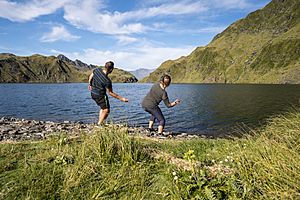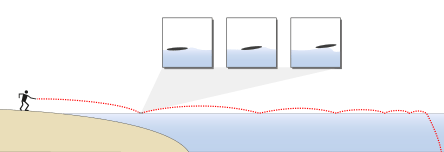Stone skipping facts for kids
Stone skipping is a fun activity where you throw a flat stone across the water. The goal is to make it bounce off the surface many times before it sinks. This is often called "skipping."
There's also something similar called stone skimming. With skimming, the goal is to see how far the stone travels across the water while bouncing, before it sinks.
In Japan, this practice is known as Mizu Kiri. This means "water cutting." In Mizu Kiri contests, judges look at how many times a stone skips, how far it skims, and how good the throw looks.
Contents
Championships and Records
People around the world love stone skipping and skimming! There are even championships where people compete to see who is the best.
In the United States, the North American Stone Skipping Association (NASSA) was started in 1989. They held world championships for a few years. Today, two main skipping contests happen in Mackinac Island, Michigan and Franklin, Pennsylvania. Other big events include the Vermont Open and the Arkansas Championship.
A major stone skimming championship takes place every year in Easdale, Scotland. Here, the distance a stone travels is most important, not just the number of skips. Since 1997, people from all over the world have joined the World Stone Skimming Championships (WSSC). They use special flat stones from Easdale Island. Each person gets three throws. The stone must bounce at least twice to count.
Other countries also have competitions. Japan holds contests that judge both skips and distance, plus the style of the throw. There are also competitions in Switzerland and sometimes in the Netherlands.
World Records
The world record for the most skips is 88! This amazing throw was made by Kurt "Mountain Man" Steiner in 2013. He achieved this record in the Allegheny National Forest, Pennsylvania. Before him, the record was 65 skips, set by Max Steiner.
For the furthest distance skimmed, the men's world record is 121.8 meters (about 399 feet). This was set by Dougie Isaacs from Scotland in 2018. For women, the record is 52.5 meters (about 172 feet), set by Nina Luginbuhl from Switzerland in the same year.
Men's World Skimming Champions
The championships in 2020 and 2021 were canceled because of the COVID-19 pandemic.
| 2019 | Péter Szép | Hungary |
| 2018 | Péter Szép | Hungary |
| 2017 | Keisuke Hashimoto | Japan |
| 2016 | Dougie Isaacs | Scotland |
| 2015 | Dougie Isaacs | Scotland |
| 2014 | Dougie Isaacs | Scotland |
| 2013 | Dougie Isaacs | Scotland |
| 2012 | Ron Long | Wales |
| 2011 | Dougie Isaacs | Scotland |
| 2010 | Dougie Isaacs | Scotland |
| 2009 | David Gee | England |
| 2008 | Eric Robertson | Scotland |
| 2007 | Dougie Isaacs | Scotland |
| 2006 | Tony Kynn | Australia |
| 2005 | Dougie Isaacs | Scotland |
| 2004 | Andrew McKinna | Scotland |
| 2003 | Ian Brown | Scotland |
| 2002 | Alastair Judkins | New Zealand |
| 2001 | Iain MacGregor | Australia |
| 2000 | Scott Finnie | Scotland |
| 1999 | Ian Shellcock | England |
| 1998 | Ian Shellcock | England |
| 1997 | Ian Sherriff | New Zealand |
| 1993 | David Rhys-Jones, Matthew Burnham, Jonathan Ford Joint winners |
Women's World Skimming Champions
The 2020 Championship was canceled because of the COVID-19 pandemic.
| 2019 | Christina Bowen-Bravery | UK |
| 2018 | Lucy Wood | England |
| 2017 | Nina Luginbuhl | Switzerland |
| 2016 | Lucy Wood | England |
| 2015 | Lucy Wood | England |
| 2014 | Helen Mannion | Scotland |
| 2013 | Lucy Wood | England |
| 2012 | Lucy Wood | England |
| 2011 | Joanne Giannandrea | Scotland |
| 2010 | Manuela Kniebusch | Germany |
| 2009 | Tessa Pirie | Scotland |
| 2008 | Jillian Hunter | Northern Ireland |
| 1997–Present (Honorable Mention) | CC Crosby | United States |
How Stone Skipping Works
Have you ever wondered how a stone bounces on water? It's all about physics! The stone creates "lift" by pushing water downwards as it moves. This is similar to how a flying disc (like a frisbee) flies. The spinning motion of the stone helps to keep it stable and balanced as it skips.
Scientists have studied stone skipping. They found that the best angle for a stone to hit the water is about 20 degrees. This angle helps the stone make the most skips. They also learned that the stone's speed and how fast it spins don't change this perfect angle. If a stone can keep its horizontal speed, it could theoretically skip forever!
For a record-breaking throw of 38 skips, a stone needed to be thrown at about 12 meters per second (25 miles per hour). It also needed to spin about 14 times every second. That's super fast!
Different Names for Stone Skipping
Stone skipping is known by many different names around the world. Here are a few:
- In English, it's often called "skipping stones" or "skipping rocks." In Britain, it's "stone skimming" or "ducks and drakes."
- In Japan, it's Mizu Kiri (water cutting).
- In Bengali, it can be "frog jumps" (Bengbaji).
- In Croatian and Serbian, people say "to throw little frogs" (bacati žabice).
- In Czech, it's often "to make froggies" (dělat žabky).
- In French, it's "making ricochets" (faire des ricochets).
- In Hungarian, it means "making it walk like a duck" (kacsáztatás).
- In Korean, it's mulsujebi, which combines "water" and a type of soup.
- In Russian, it's simply "frogs" (Lyagushki).
- In Spanish, it can be "making little frogs" (hacer ranitas) or "making ducklings" (hacer patitos).
- In Swedish, it's "throwing a sandwich" (kasta smörgås).
See also
 In Spanish: Cabrilla para niños
In Spanish: Cabrilla para niños



